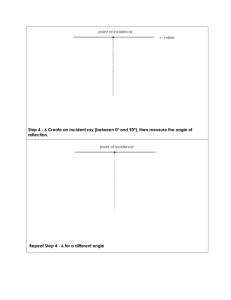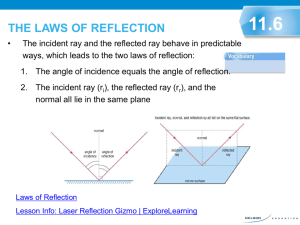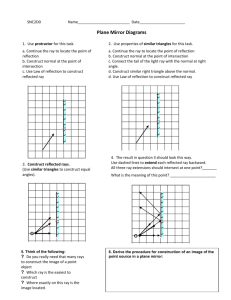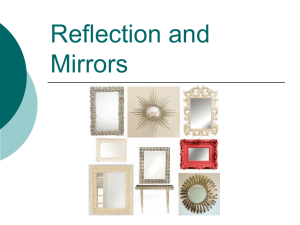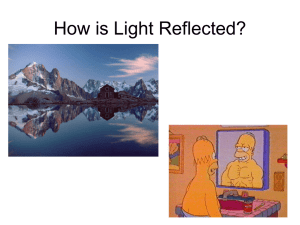10.2 Properties of Light & Reflection
advertisement
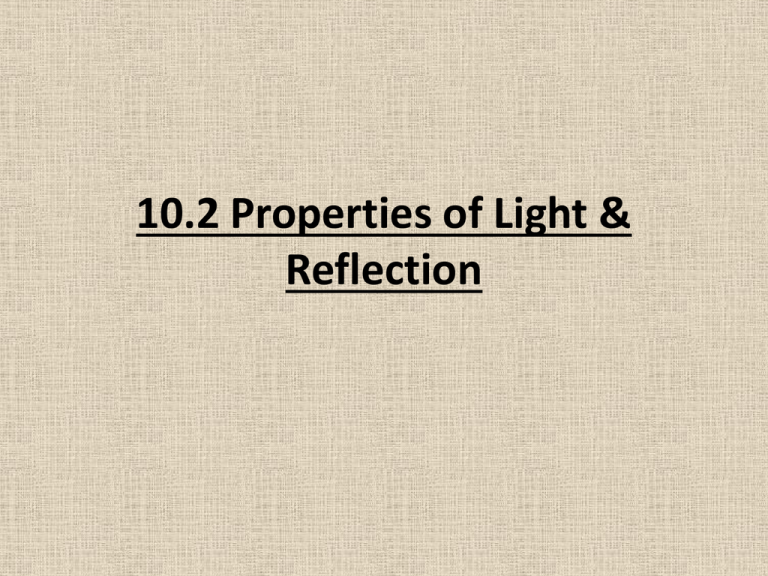
10.2 Properties of Light & Reflection The Behaviour of Light: • A reflection is the change in direction of a wave when it reaches the surface and bounces off of it. All natural light that hits your eyes, originally came from the sun. This light reflected off of objects and then reached your eyes. To see your own reflection in a lake, light had to have reflected off of you towards the water and then reflected off of the surface of the water to finally reach your eyes. • When light travels through one medium, it travels in a straight line. A medium is a term for the substance that light travels through. We can visually demonstrate the motion of light through ray diagrams. A ray is a straight line with an arrowhead representing light travelling in one direction. • Ray diagrams can be used to predict the location, size and shape of the shadows of two objects. Consider Figure 10.13 in the textbook. We can see how light rays emitted from one light source travels towards two solid objects at different distances from the light bulb. The object which is closer to the light source casts a larger shadow than the further object. • Fermat’s Principle: This principle states that light will follow the path that will take the least amount of time. In other words, light will take the shortest path. This principle can be used to predict where light will go after reflecting off of a surface. • The incident ray is the ray of light which heads towards a surface. The angle of incidence is the angle that the incident ray makes with the normal (a perpendicular line drawn from the point of contact of the incident ray with the surface). The reflected ray is the ray of light which reflects off of the surface. The angle of reflection is the angle between the reflected ray and the normal. The incident ray, normal and reflected ray all lie on the same plane. • The Law of Reflection states that the angle of incidence (θi) always equals the angle of reflection (θr) such that the incident and reflected ray, as well as the normal, lie on the same plane. To draw a ray diagram, we should follow these steps: 1. Draw the incidence ray using a ruler. 2. At the contact point where the incident ray hits the surface, draw a normal by measuring 90o with a protractor. 3. Measure the angle of incidence (i) between the incident ray and the normal. Make a mark to indicate the same angle on the other side of the normal. This is the angle of reflection. 4. Draw the reflected ray from the contact point through the mark using a ruler. 5. Label the incident ray, the reflected ray, the angle of incidence (i), the angle of reflection (r) and the normal. Images in Plane Mirrors: • If you place an object in front of a mirror, you will see an image of that object shown in the mirror. We can use the laws of reflection to figure out where the image will be and what the image will look like. Figure 10.15 shows a blueberry placed in front of a mirror. Light rays will reflect off of that blueberry in all directions. Some will head towards our eyes (allowing us to see the blueberry) while others will travel towards the mirror. When these rays reach the mirror, they will reflect off of the mirror. Some of these rays will reach our eyes allowing us to see the image of the blueberry in the mirror. Our brain is tricked by the mirror. It assumes that when we light rays hit our eyes, it must have come from a straight line. If we extend straight lines from our eyes back towards the mirror, along the reflected ray, we can determine where our brain thinks that the light rays are originating from. These extended rays are represented by the dashed diagram in the figure. Therefore our eyes “see” the blueberry at this spot “behind” the mirror. • The image that we see “behind” the mirror is a virtual image. A virtual image is one in an image in which light rays only appear to be originating from. To determine whether an image that we see is real or virtual, we can place a screen where we think the image is. If light rays hit the screen to form an image, then this image is real. If no light rays hit the screen and there is no image seen, then the image is virtual.
